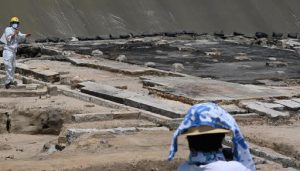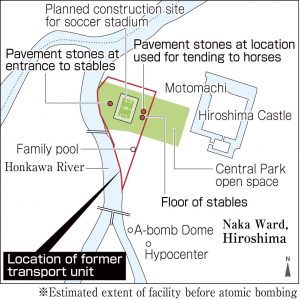Striving to fill voids in Hiroshima, evidence of victims remains 76 years after atomic bombing—Hiroshima City decides to relocate sections of “Shichotai” remnants from soccer stadium site
Aug. 18, 2021
by Kyosuke Mizukawa, Staff Writer
On August 17, the Hiroshima City government announced that three sections of the remnants of a former military facility would be relocated. The facility belonged to the former Japanese Army’s transport unit known as the Chugoku District transport soldier recruitment unit (“Shichotai,” in Japanese), which was destroyed in the atomic bombing of the city. The Shichotai artifacts were discovered during excavation of the planned site for a new soccer stadium in Hiroshima’s Central Park, located in the city’s Naka Ward. Taking into consideration the fact that military horses played an important historical role in the transportation of goods on the battlefield, the city is to relocate sections of the stable floors and other artifacts. The work to relocate the three sections and remove the other areas of the remnants will begin as early as August 23.
Two of the three sections to be relocated are situated on the east side of the soccer stadium site, and the other section is located on the park’s west side. On the east side are 12 stones, each measuring 0.9-by-0.4 meters, used as pavement for the location used to care for horses, as well as an asphalt horse-stable floor 1.5-by-4.0 meters in size. On the west side are 25 pavement stones, each measuring 1.0-by-0.5 meters, at the entrance to the horse stables there. The total area of the three sections measures 23 square meters, or 0.4 percent of the 6,000 square meters surveyed.
According to the city government, seven members of the city’s ten-member Cultural Property Council individually surveyed the site starting in late July, providing the city with advice as to what sections of the remnants should be preserved. To what location the three sections should be moved and their uses are two issues that will be determined by March of next year, the end of the current fiscal year. “We want to utilize the sections to communicate widely one aspect of pre-war Hiroshima,” said a staff member at the Hiroshima City government’s Cultural Promotion Division.
Six A-bomb survivor and peace groups, including the two Hiroshima Prefectural Confederations of A- and H-bomb Sufferers Organizations, demanded that the city government listen to the opinions of experts, A-bomb survivors, and residents in open hearings before deciding what to do with the facility remnants. Satoshi Tanaka, 77, secretary general of the Hiroshima Alliance of A-bomb Survivor Organizations, said, “It’s deplorable that the city government has announced what it will do with the important remains in the A-bombed city while making light of our demands.”
In October last year, the city government began an excavation survey of the construction site for the soccer stadium to make a record of the present circumstances underground. Discovered in the process were the remnants of the Shichotai facility, which was destroyed in the atomic bombing. Earlier in July, Hiroshima Mayor Kazumi Matsui announced the city’s plan to relocate certain sections of the remnants.
(Originally published on August 18, 2021)
On August 17, the Hiroshima City government announced that three sections of the remnants of a former military facility would be relocated. The facility belonged to the former Japanese Army’s transport unit known as the Chugoku District transport soldier recruitment unit (“Shichotai,” in Japanese), which was destroyed in the atomic bombing of the city. The Shichotai artifacts were discovered during excavation of the planned site for a new soccer stadium in Hiroshima’s Central Park, located in the city’s Naka Ward. Taking into consideration the fact that military horses played an important historical role in the transportation of goods on the battlefield, the city is to relocate sections of the stable floors and other artifacts. The work to relocate the three sections and remove the other areas of the remnants will begin as early as August 23.
Two of the three sections to be relocated are situated on the east side of the soccer stadium site, and the other section is located on the park’s west side. On the east side are 12 stones, each measuring 0.9-by-0.4 meters, used as pavement for the location used to care for horses, as well as an asphalt horse-stable floor 1.5-by-4.0 meters in size. On the west side are 25 pavement stones, each measuring 1.0-by-0.5 meters, at the entrance to the horse stables there. The total area of the three sections measures 23 square meters, or 0.4 percent of the 6,000 square meters surveyed.
According to the city government, seven members of the city’s ten-member Cultural Property Council individually surveyed the site starting in late July, providing the city with advice as to what sections of the remnants should be preserved. To what location the three sections should be moved and their uses are two issues that will be determined by March of next year, the end of the current fiscal year. “We want to utilize the sections to communicate widely one aspect of pre-war Hiroshima,” said a staff member at the Hiroshima City government’s Cultural Promotion Division.
Six A-bomb survivor and peace groups, including the two Hiroshima Prefectural Confederations of A- and H-bomb Sufferers Organizations, demanded that the city government listen to the opinions of experts, A-bomb survivors, and residents in open hearings before deciding what to do with the facility remnants. Satoshi Tanaka, 77, secretary general of the Hiroshima Alliance of A-bomb Survivor Organizations, said, “It’s deplorable that the city government has announced what it will do with the important remains in the A-bombed city while making light of our demands.”
In October last year, the city government began an excavation survey of the construction site for the soccer stadium to make a record of the present circumstances underground. Discovered in the process were the remnants of the Shichotai facility, which was destroyed in the atomic bombing. Earlier in July, Hiroshima Mayor Kazumi Matsui announced the city’s plan to relocate certain sections of the remnants.
(Originally published on August 18, 2021)









